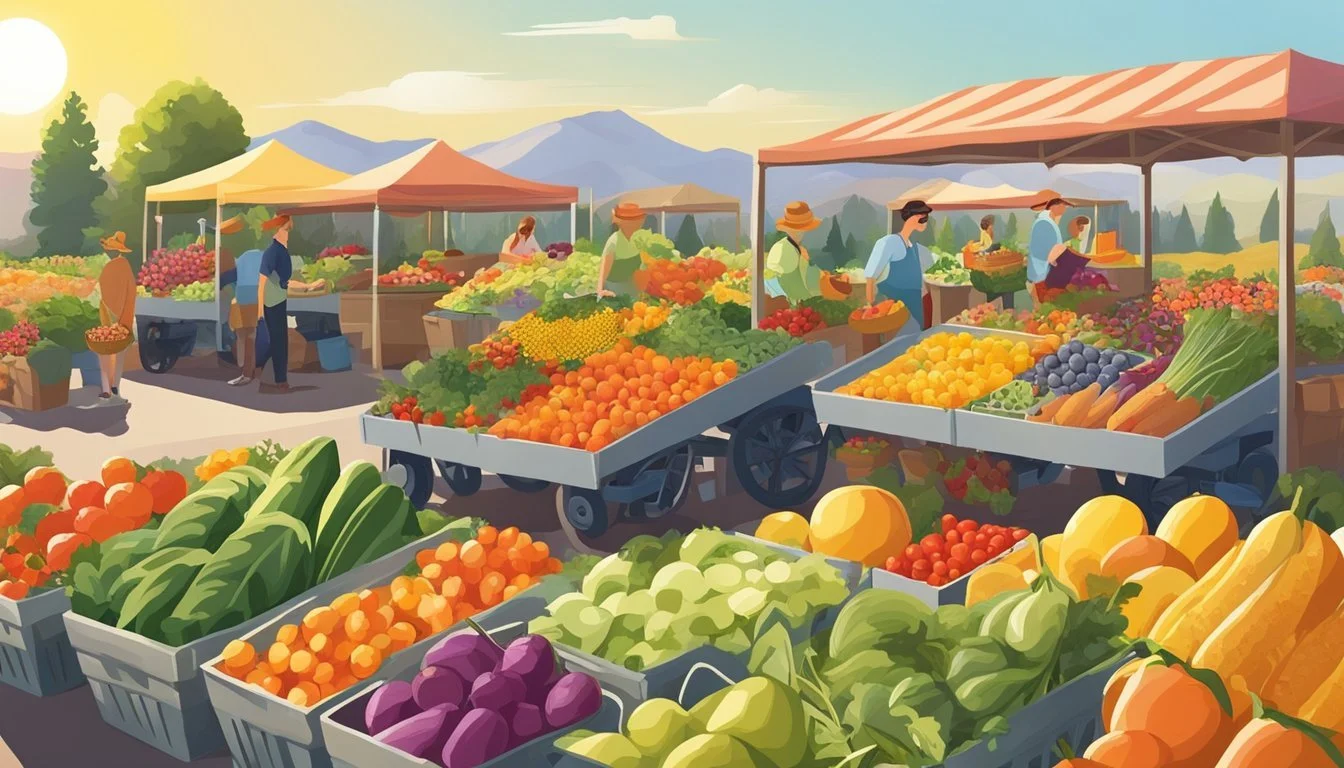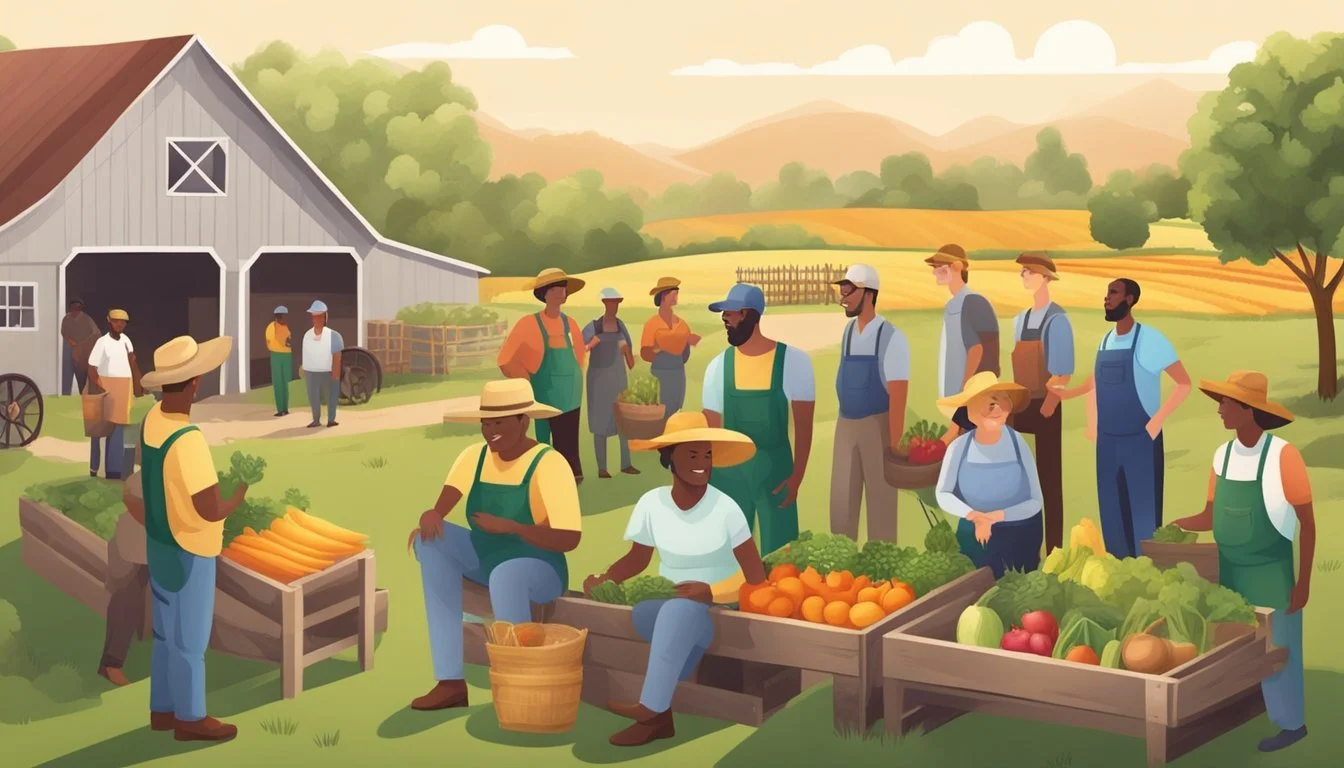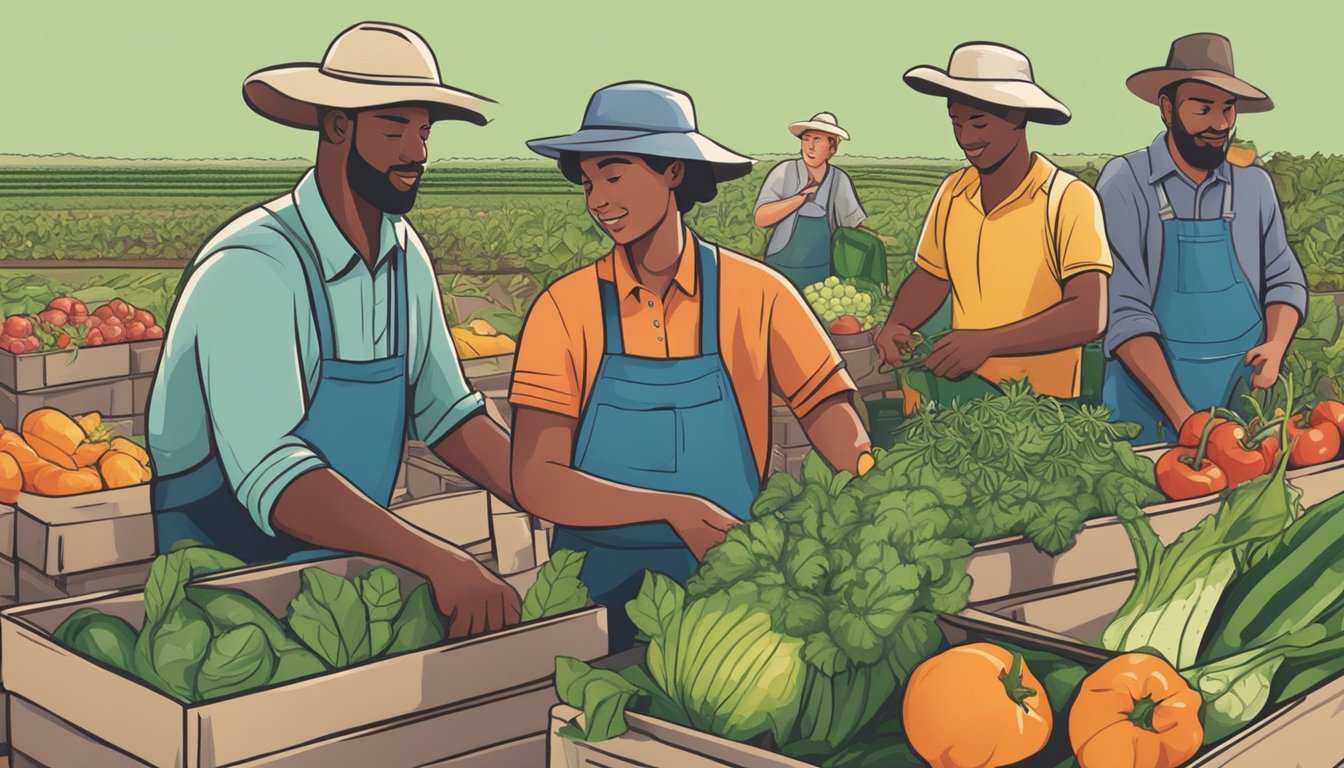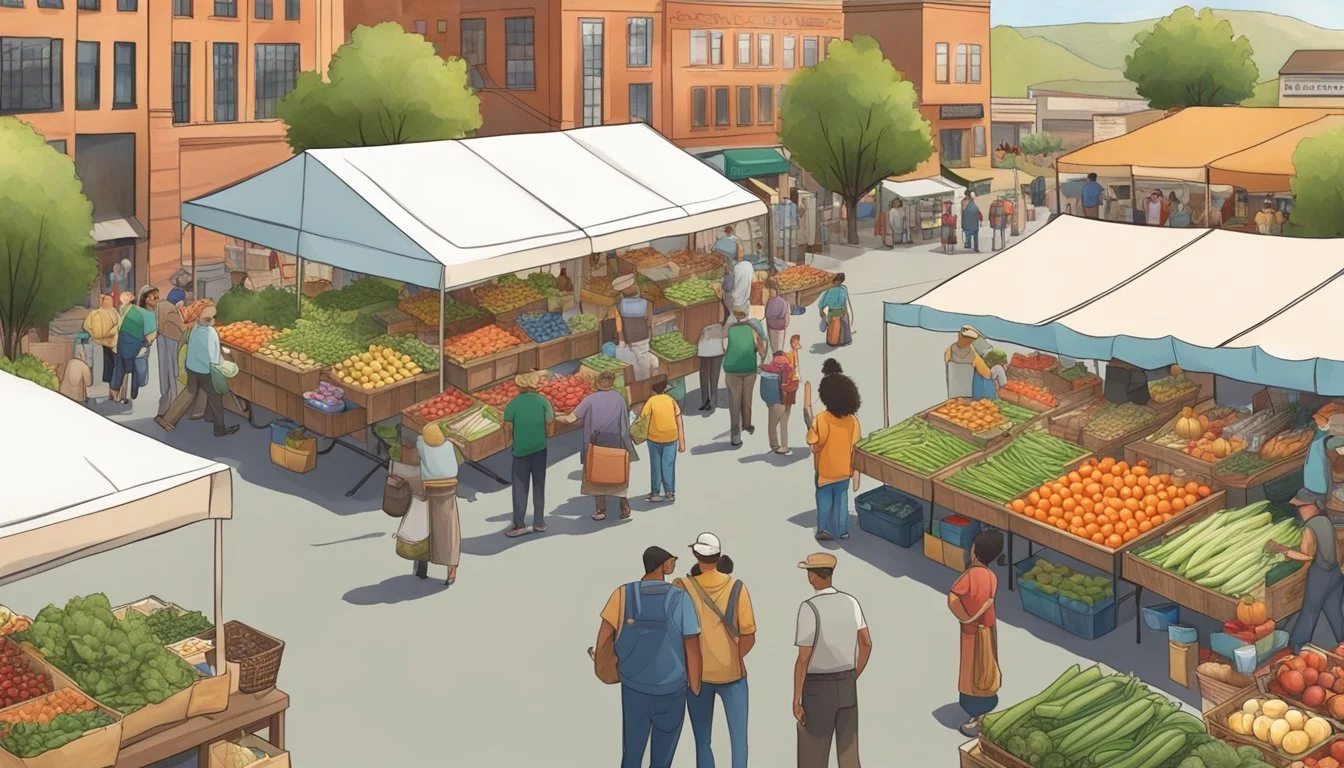Community Supported Agriculture (CSA) in Utah
Benefits and Local Impact
Community Supported Agriculture, commonly known as CSA, has been gaining ground in the state of Utah as a sustainable agricultural practice that benefits both local farmers and consumers. Through CSA programs, consumers can purchase a share of a farm's harvest in advance, providing the farmer with predictable revenue and an established market. This model fosters an intimate connection between Utah residents and the food they eat by encouraging them to directly support local agriculture.
Utah's own CSA initiatives are examples of how this agricultural concept can thrive in diverse regions across the United States. Supported by state programs and a growing interest in local food systems, these CSAs allow Utahns to enjoy fresh produce while also supporting the state's agricultural economy. By keeping food dollars within local communities, CSAs contribute to the development and maintenance of Utah’s regional food systems and offer a practical solution to the modern challenges of food sourcing and sustainability.
In Utah, CSA's importance is magnified by the direct communication and cooperation it encourages between farmers and consumers. Not only does this model provide farmers with a fair return on their labor, but it also educates consumers about the seasonality of food and the realities of farming. As residents of Utah become increasingly invested in where their food comes from, CSA programs are set to play an essential role in the state's agricultural landscape, championing the values of community building and environmental stewardship.
History and Principles of CSA
Community Supported Agriculture (CSA) in Utah links local farmers with community members through the sale of seasonal produce shares, embodying principles of sustainability and mutual support.
Origins of Community Supported Agriculture
The concept of CSA originated in the 1960s in Germany, Switzerland, and Japan as a response to food safety concerns and the urbanization of agricultural land. It reached the United States in the 1980s, and the first CSA was founded at Indian Line Farm in Massachusetts. The CSA model has spread across the country, including Utah, allowing for close community-farmer relationships and locally-sourced food supplies.
Core Values and Ethos
The core values of CSA are founded on a mutually supportive relationship between local farmers and community members. Key principles include:
Community Engagement: Encouraging direct participation of consumers in the local food system.
Economic Stability: Providing a stable and fair income source for farmers through upfront share purchases.
Sustainable Practices: Advocating for agricultural methods that foster soil health and ecological balance.
Shared Risk and Reward: Embracing the inherent risks of farming by collectively supporting growers, which in turn leads to shared benefits.
CSA members typically purchase a "share" of the season's harvest, which directly contributes to the agricultural financial stability, local economy, and valuation of sustainable food practices. Through these shares, consumers receive regular distributions of farm products, forming a community around agriculture that is invested in both its practices and its yields. This model ensures that food dollars remain within the local community and fortify it against the uncertainties of large-scale food production and distribution.
How CSA Works
In Utah, Community Supported Agriculture (CSA) functions through a symbiotic relationship between local farmers and consumers. Members purchase shares of the harvest upfront, which provides them with regular allocations of fresh, high-quality produce, and gives farmers a stable source of income.
Membership and Shares
A membership to a CSA involves consumers—often referred to as members—paying for a share of the anticipated harvest at the beginning of the growing season. This financial commitment typically covers the entire growing period and is calculated based on the amount of produce they will receive. Here's how a typical CSA membership is structured:
Full Share: Ideal for families; provides a larger quantity of vegetables and fruits.
Half Share: Suitable for individuals or couples; offers a smaller selection of seasonal produce.
Members are essentially investing in the farm, and in return, they receive fresh products weekly or bi-weekly over the harvesting season.
Distribution of Produce
The distribution of produce is a critical component of a CSA. Farms distribute their goods through different models:
Pick-Up Points: Specific locations where members can collect their shares of vegetables and fruit.
Delivery: Direct delivery to the member's home or a convenient location.
The distribution emphasizes consistency in quality and freshness, with items often harvested within a day of delivery. CSA operations focus on a farm-to-table approach, ensuring that consumers receive the best products seasonally available.
Benefits of CSA
Community Supported Agriculture in Utah offers a mutualistic relationship among consumers, farmers, and the environment. This section elaborates on the specific benefits for each of these key stakeholders.
Advantages for Consumers
Freshness and Quality: CSA members enjoy fresh produce, often harvested within hours of delivery. This ensures a higher quality and more flavorful experience than many store-bought options.
Health and Variety: Consumers receive a diverse array of produce, which can include organic options. This diversity encourages a healthier diet rich in fruits and vegetables.
Advantages for Farmers
Stable Income: Local farmers gain financial security through pre-season funding from member shares, allowing them to focus on sustainable farming practices.
Community Connection: Farmers receive direct feedback and build relationships with their customers, which can lead to a loyal consumer base and potential for community growth.
Environmental Benefits
Ecosystem Health: CSA supports farming practices that benefit the ecosystem, often integrating organic methods that reduce the use of harmful chemicals.
Reduced Carbon Footprint: With a focus on local food supply, CSAs cut down on long-distance transportation, leading to a notable decrease in carbon emissions.
CSA in Utah: An Overview
Community Supported Agriculture in Utah fosters a robust connection between local farmers and the community. It provides an effective system for consumers to receive fresh produce while supporting the economy and farmers directly.
Prominent CSA Farms
In Utah, several farms offer CSA programs where consumers can purchase a share of the harvest. These CSA farms vary in size and specialty, but they all share a commitment to providing seasonal, locally-grown produce directly to their members. For example, Wheeler Farm is known for hosting an annual CSA Open House, which serves as a platform for different local farms to showcase their offerings.
Impact on Local Economy
The involvement of local farms in the CSA model has notable effects on the Utah economy. Research from Utah State University suggests that investing in local CSAs keeps food dollars within the community and contributes to the development of regional food systems. By relying less on imported food, Utah's economy can retain more wealth locally. A CSA's guaranteed market provides stability for farmers, further strengthening the community's economic base.
Economic Aspect Detail Food Dollars Largely retained within the local community Local Farming Encourages sustainable practices Market Stability Offers farmers a guaranteed market for their produce
Challenges and Considerations
The success of Community Supported Agriculture (CSA) in Utah is hinged on navigating a set of intrinsic challenges. From economic sustainability to adherence to regulations, each aspect requires careful consideration to maintain a robust CSA model.
Economic and Operational Challenges
Economic sustainability is a primary concern for CSAs in Utah. Farmers must strike a balance between the costs of labor and production and the feasible price points for community shares. With the ever-present threat of climate change, unpredictable weather patterns can disrupt expected yields, further straining financial stability. Additionally, the necessity for continuous community engagement places CSAs in a position where they must invest in marketing and outreach to secure a stable customer base.
Labor: Access to consistent and affordable labor is crucial for the smooth operation of CSA farms.
Climate Effects on Yield: Adapting farming practices to cope with changing climate conditions can present a real economic challenge.
Sustainable Farming Practices
CSAs inherently promote sustainable farming practices by encouraging local food production and reducing transportation emissions. Critical to this system is the maintenance of soil health through natural methods, such as composting. Farmers must also educate their members about the limitations and variations inherent in local food supply, which can be affected by sustainable practices designed to protect the long-term viability of the farm.
Composting: A practice that enriches the soil but also requires an investment of resources and education.
Soil Health: Farmers place significant focus on conserving soil quality, which is directly linked to the long-term sustainability of the CSA operations.
Legal and Regulatory Factors
Finally, CSAs in Utah must navigate a complex web of legal and regulatory factors. This can range from food safety regulations to business and employment laws. Complying with these rules ensures the legitimacy and continuity of CSA operations but also involves a web of bureaucracy that can be demanding for small-scale farmers.
Food Safety Regulations: Ensuring produce meets health standards is vital but can be resource-intensive.
Business Compliance: Navigating zoning laws, tax codes, and employment regulations is essential for legal CSA functioning.
Role of CSA in Community Building
Community Supported Agriculture (CSA) in Utah not only facilitates the trade of fresh produce but also strengthens the fabric of the local community. Through educational programs and collaborative efforts, CSA initiatives in Utah enrich the bond between consumers and producers.
Educational Outreach and Events
CSA initiatives in Utah place a significant emphasis on education and stewardship. They often organize educational outreach activities that enhance community members' knowledge of sustainable agriculture. For example, Moab Grown, a concept embraced by several CSA programs in Utah, fortifies the understanding and appreciation of locally-sourced food by facilitating field events. These events often involve:
Community chefs demonstrating cooking with local products.
Workshops educating participants on the importance of know your farmer.
Tours that allow community members to see firsthand the impact of their support.
These engagements serve as vital touchpoints, ensuring that education extends beyond the transaction and becomes an integral part of community building.
Community Collaboration
CSAs in Utah have become a nexus for community collaboration, leading to the creation of robust local food systems. Collaboration spans across multiple entities and involves:
Local Community: Engaging citizens in a shared goal of supporting local agriculture.
Farmers: Providing them with a guaranteed market for their produce.
Marketplace: Establishing a direct link between the producer and the consumer.
Through such partnerships, CSAs enforce a model of shared responsibility where each party plays a role in sustaining the agricultural landscape of the region. This type of collaboration not only ensures economic benefits but also fosters a collective identity centered around food security and local prosperity.
Future of CSA in Utah
Community Supported Agriculture in Utah is poised for growth through innovative practices and increased support methods. Stakeholders including policymakers, consumers, and agricultural institutions like Utah State University are key in driving this sector's development.
Innovation and Trends
Utah State University plays a crucial role in spearheading agricultural innovation, with research aimed at sustainable farming practices and adaptation strategies to address climate change. Emerging trends such as precision agriculture, which involves using technology to optimize field-level management, can enhance efficiency and productivity in CSA operations. Adoption of such technological advancements is crucial for scaling up CSAs and ensuring long-term viability.
Technological Integration: Smart farming techniques, including the use of IoT devices for soil and crop health monitoring, are increasingly popular.
Sustainable Practices: Environment-conscious methods, such as permaculture design and water-conservation strategies, are being adopted to mitigate the impact of climate change.
Supporting CSA Growth
Support for CSA growth in Utah involves fostering community relations and encouraging behavior changes towards local foods. Government initiatives and local support structures can leverage educational campaigns to increase awareness and participation in CSAs.
Policy Incentives: Financial and regulatory support can motivate farmers to join or expand CSA programs.
Public Engagement: Educational programs associated with the likes of Utah State University can instigate behavior changes, driving consumer preference for CSA-produced goods.
Utah's commitment to CSA is evident through continuous efforts in innovation and growth, setting a foundation for a resilient and thriving local agriculture ecosystem.
How to Get Involved with CSA
Community Supported Agriculture (CSA) in Utah connects consumers directly to local farmers, providing fresh, high-quality products while strengthening the farming community. Through CSA, individuals have the opportunity both to support local agriculture and to receive a share of the harvest throughout the farming season.
Finding Local CSA Opportunities
To find CSA opportunities in Utah, potential members can attend events like the annual Community Supported Agriculture Open House, typically held in locations such as the Activity Barn at Wheeler Farm. These events offer the chance to meet local farmers and compare various CSA programs.
Local Resources:
CSA Utah Website: Comprehensive information about CSA farms.
Farmers' Markets: Interaction with farmers offering CSA shares.
Agricultural Extensions: Guidance on CSA availability.
One can also leverage local directories or social media groups dedicated to Utah's agricultural offerings to pinpoint farms participating in CSA programs.
Starting a CSA Farm
For those interested in starting a CSA farm in Utah, understanding local community needs is vital. Prospective CSA farmers should consider the following steps:
Research:
Study successful CSA models.
Learn about crop planning suited to Utah's climate.
Community Outreach:
Determine community interest through surveys or community meetings.
Engage with local food initiatives and agricultural organizations.
Legal and Financial Planning:
Secure land with appropriate zoning for agriculture.
Develop a business plan with clear member subscription models.
Marketing:
Create a solid online presence.
Network at local events and with other CSA farms.
Prospective CSA farmers provide an invaluable service by delivering diverse food options to Utah residents, enhancing the local food system, and contributing to both environmental sustainability and community well-being.








